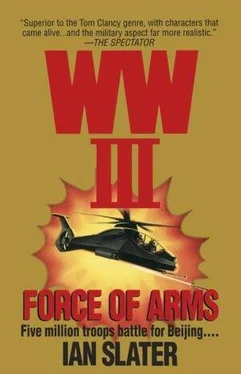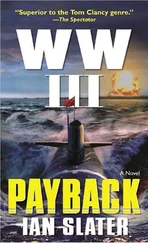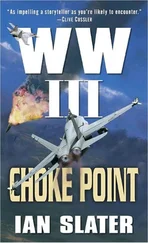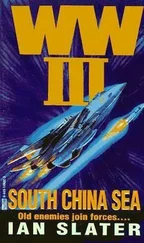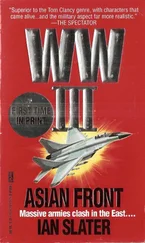“Missiles ready,” the weapons officer reported after having checked each one’s housing to make sure it was ready to pass through its prelaunch modes.
“Flood Tomahawk tubes.”
“Flood Tomahawk tubes.”
“Tubes flooding, sir.” There was a few seconds’ delay as the water poured into the vertical housing, filling the space between the elastomeric shock-absorber liners and the Tomahawk missiles themselves. Brentwood inserted his key to complete the firing circuitry, giving his independent authority to launch.
“Stand by for ripple fire,” Brentwood said.
“Stand by for ripple fire,” the weapons officer repeated.
“Fire one,” Brentwood ordered.
“Fire one.”
“Fire two.”
“Fire two.”
“Fire three.”
“Fire three.”
“Fire four.”
“Fire four. All fired.”
The Tomahawks rose from their housings, breaking the water-missile interface protective membrane, and within seconds were through the water into the air, their fiery tails first giving off smoke and looking as if they were skidding sideways for a time, then rising higher and higher before leveling out and going into their TERCOM — terrain contouring mode — in which each missile would sweep in over die Chinese coast, its television eye recording the topography, matching it with that of the target fed into the computer before launch. The missile would not come down until the exact configuration seen by its TV eye matched the preprogrammed picture of the target — like a hand moving toward its mirror image. Having made the matchup it would “down turn” to complete its homing lock-on.
“Where the hell they going?” an electrician’s mate, Holmes, asked.
“China, man.”
“Yeah but whereabouts?”
“Dunno, man. Skipper got the orders to press the button. He pressed it. Wherever they’re gonna land it’s hasta la vista, baby.”
“And now,” Holmes said, “every mother within a hundred miles of us knows where we are.”
“Hey, man, that’s why we’re half missile launcher and half HUK.” He meant Hunter-Killer. “They want to come for us we can play. Why you think the old man loaded those four Mark 48s in the tubes? He’s ready.”
“Hope so,” Holmes said.
“Know so,” the mate said.
* * *
The Chinese sub Perch heard the launch on its passive sonar but could not fix range unless it used its active sonar, and to use that would be to let the Americans know precisely where it was. It preferred to risk surfacing for a quick high-burst radio message to the naval base at Qingdao, which in turn alerted its flotillas of fast, standard, and hydrofoil gunboats, most particularly the Soviet-built Osa 1 guided-missiles boats with a speed of thirty-six knots, a range of five hundred nautical miles, and armed with four surface-to-surface Styx missiles and one surface-to-air N-5 launcher.
But the gunboat flotilla wasn’t at all interested. It had already been dispersed up and down the coast, concentrating particularly along the 120-mile strip between Xiamen and Putan opposite Taiwan, from where Admiral Kuang’s invasion had established a beachhead near Xiamen.
With no interest shown by the Brown Wave Navy, the Chinese sub skipper decided to resume his patrol in the direction of the American Sea Wolf alone. If it missed the Sea Wolf and could no longer hear its water pump, then there was still a chance to take a bite out of the big U.S. carrier group itself. The Perch could go to the bottom, cut its engines, and wait, silent, ready to attack on battery power alone.
* * *
At Honggor, things were falling apart. The Americans were not overwhelmed by the far more numerous Chinese but were caught in a draw, and a draw wasn’t good enough, for ultimately the Chinese sea of armor and the troop and matériel reinforcements being rushed by rail from Shenyang’s northern armies in Manchuria must turn the tide against the U.S. forces.
This day the second in command to Freeman, General Leigh, commander to the Orgon Tal-Honggor front, decided that the only thing to do, especially given the snags that Freeman’s SAS/D troop were running up against, was to call in the Marine Expeditionary Force. It was time to turn the feint into a reality at Beidaihe’s Middle Beach. He was on the radio asking Freeman for permission to call in the marines. “Request Golf Force.”
“Permission granted,” Freeman said. “Disembarkation at fourteen hundred hours. Repeat, fourteen hundred hours.” At the time, no one thought to question why Freeman was so emphatic about 1400 hours. In any case, on hearing “permission granted,” the 48,000-strong Marine Expeditionary Force was instructed to execute “Golf Force,” to hit the Chinese east flank at Beidaihe. And Robert Brentwood knew he would have to blow the hidden beach obstacles.
As the USS Reagan detached itself from the main force and raced ahead at forty knots submerged, the ChiCom sub Perch remained on silent station. It came to periscope depth and glimpsed one of the DDG-51 — class Flight III guided-missile destroyers only five miles away. The control room was charged with excitement as the Perch’s captain, known to his crew as Xingyuner — Lucky — decided to wait no longer for the appearance of an American sub. On the basis of one in the hand being better than two in the bush, he aligned his tubes, running silent on battery power alone, in the direction of the coming destroyer. As he snappily took the bearing, a Sea King helo from the American state-of-the-art destroyer rose from the ship’s after deck and began a routine ASW search over a predetermined grid pattern by hovering in the middle of each grid, letting down its dipping sonar, which, sending out an active pulse, could wait to see if there was any sound. It received an echo in 1.2 seconds and, allowing for the local salinity, told the two pilots and two sonar operators aboard the Sea King that there was a sub in the immediate area.
The captain of the helo already had a computer list spewing out, telling him the type and location of all Allied subs and surface vessels in the area. The only one in general proximity was the USS Reagan, and it was on a heading thirty-one miles away and only five miles from the China coast. The Sea King notified its destroyer that it was attacking, and dropped a 9.5-foot-by-12.75-inch 805-pound Mark 50 ASW torpedo. When it hit the water it went into active acoustic homing mode, streaking toward the Perch at 42.7 knots.
Aboard the Perch they heard it coming, and the captain ordered hard to starboard, battle speed. As soon as it turned, the Sea King had its bearing via the dipping sonar mike and dropped the second Mark 50. The first torpedo missed but exploded near the sub; the second’s hundred-pound warhead hit the Chinese sub midships but did not explode. Assorted debris popped up from the site of the first explosion, followed by a large bleed of oil.
The USS Reagan heard the explosion but kept on toward Beidaihe.
“May just be a fake,” the pilot of the Sea King reported. “The oil and debris.” But the fleet had no time or torpedoes to waste, for it was critical that the Marine Expeditionary Force make an on-time coordinated attack, and so the Sea King returned to scouting ahead for the frigate, the encounter with the sub logged as a possible sinking of a Chinese diesel sub.
* * *
In the Hall of Supreme Harmony there was a bloody and air-shattering firefight between David Brentwood’s troop of twenty-seven men, all that remained out of the original forty — and six of the twenty-seven were wounded — and elements of Special Security Unit 8431, who, now that the Americans had been boxed in in the hall, were letting rip from the top of the Gate of Supreme Harmony two hundred yards away with AK-7.62mm and light type 81-1T-74 7.62mm machine guns, their drum magazines interchangeable.
Читать дальше
